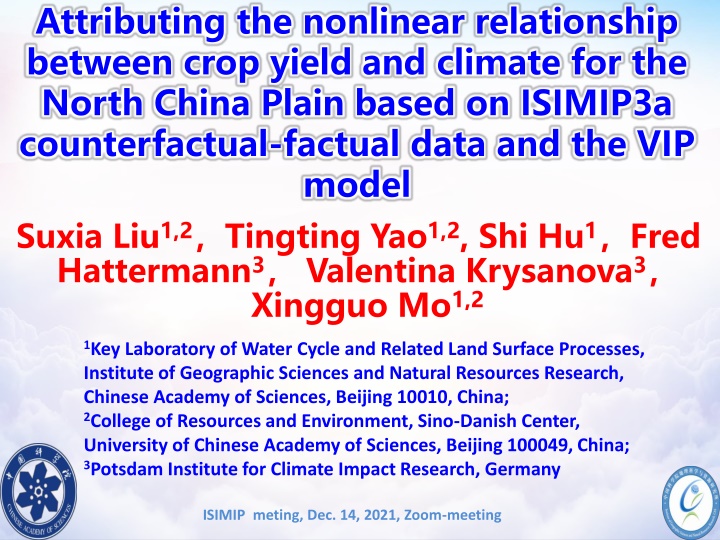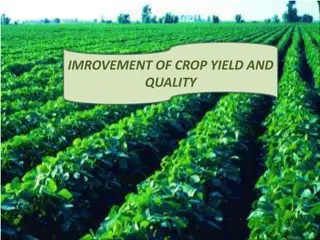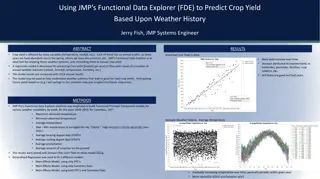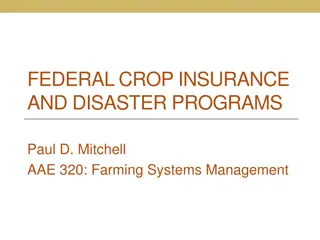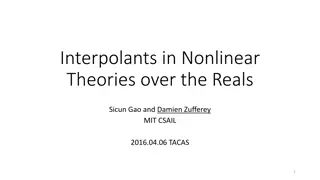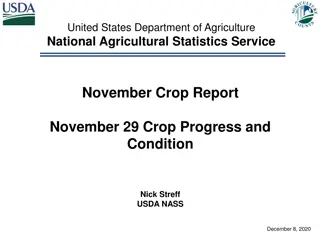Nonlinear Relationship Between Crop Yield and Climate in North China Plain
Attributing the nonlinear relationship between crop yield and climate for the North China Plain based on ISIMIP3a data and the VIP model. Temperature projections, CO2 fertilization effects, precipitation impact, and suggestions for climate change adaptation are discussed. Recent research confirms significant impacts of climate change on crops in the region.
Download Presentation

Please find below an Image/Link to download the presentation.
The content on the website is provided AS IS for your information and personal use only. It may not be sold, licensed, or shared on other websites without obtaining consent from the author.If you encounter any issues during the download, it is possible that the publisher has removed the file from their server.
You are allowed to download the files provided on this website for personal or commercial use, subject to the condition that they are used lawfully. All files are the property of their respective owners.
The content on the website is provided AS IS for your information and personal use only. It may not be sold, licensed, or shared on other websites without obtaining consent from the author.
E N D
Presentation Transcript
Attributing the nonlinear relationship between crop yield and climate for the North China Plain based on ISIMIP3a counterfactual-factual data and the VIP model Suxia Liu1,2 Tingting Yao1,2, Shi Hu1 Fred Hattermann3 Valentina Krysanova3 Xingguo Mo1,2 1Key Laboratory of Water Cycle and Related Land Surface Processes, Institute of Geographic Sciences and Natural Resources Research, Chinese Academy of Sciences, Beijing 10010, China; 2College of Resources and Environment, Sino-Danish Center, University of Chinese Academy of Sciences, Beijing 100049, China; 3Potsdam Institute for Climate Impact Research, Germany ISIMIP meting, Dec. 14, 2021, Zoom-meeting
Background Based on our VIP model, with the projection of the temperature rising 2 and 5 increasing and decreasing by 15% and 30%, atmospheric CO2 enriching to 500 and 700ppmv, at the two typical counties in the, Botou in the north and Huaiyuan in the south of a winter wheat-summer maize cropping system in Huang-Huai-Hai (3H) Plain (covering most of the North China Plain) , totally 96 simulation combinations, our previous research (Liu et al., AFM, 2009) shows that the effects of climate change on grain production are significant. The projected crop yields are significantly different from the baseline yield (1996-2004), with the minimum, mean ( standardized deviation, SD) and maximum changes being -46%, - 10.3 20.3%, and 49%, respectively. The overall yield reduction of -18.5 22.8% for a 5 2.3 13.2% for a 2 C increase. The negative effect of temperature rise on crop yield is partially mitigated by CO2 fertilization. The response of a C3 crop (wheat) to the temperature rise is significantly more sensitive to CO2 fertilization and less negative than the response of C4 (maize), implying a challenge to the present double wheat-maize systems. Increased precipitation significantly mitigated the loss and increased the projected gain of crop yield. Conversely, decreased precipitation significantly exacerbated the loss and reduced the projected gain of crop yield. Irrigation helps to mitigate the decreased crop yield, but CO2 enrichment blurs the role of irrigation. The crops in the wetter southern 3H Plain (Huaiyuan) are significantly more sensitive to climate change than crops in the drier north (Botou). Thus CO2 fertilization effects might be greater under drier conditions. The study provides suggestions for climate change adaptation and sound water resources management in the 3H Plain. C, precipitation C increase is significantly greater than -
Background These significant impacts of climate change to the crops in North China Plain were confirmed by the very recent research conducted by Jonas J germeyr s team published in Nature Food 2021, based on the output of five CMIP6 (the international Climate Model Intercomparison Project) climate models as the input to 12 crop models of the Agricultural Model Intercomparison and Improvement Project (AgMIP), totally 240 global climate-crop model simulations: Maize in China, as the same as in other countries nearer the equator, in cluding North and Central America, West Africa, Central Asia, Brazil will potentially see their maize yields decline in the coming years and beyond as average temperatures rise across these breadbasket regions, putting more stress on the plants. Wheat, in North China Plains, as the same as other area in temperate climates, may see a broader area where it can be grown as temperatures rise, including the Northern United States and Canada, Central Asia, Southern Australia, and East Africa, but these gains may level off mid-century. Higher temperatures affect the length of growing seasons and accelerate crop maturity. But temperature is not the only factor the models consider when simulating future crop yields. Higher levels of carbon dioxide in the atmosphere have a positive effect on photosynthesis and water retention, increasing crop yields, though often at a cost to nutrition. This effect happens more so for wheat than maize. Global changes in rainfall patterns, the frequency and duration of heat waves and droughts, all can affect crop health and productivity.
Scientific issue /hypothesis By using both obsclim and counterclim of ISIMIP3a data and the VIP(vegetation interface processes) distributed eco-hydrological model, the nonlinear relationship between crop yield and climate is attributed in North China plain.
Value of the study The area affected by droughts in the recent decades is much lower than the years before in North China Plain. While there are many climatic factors contributing to this beneficial trend, it is easy to be more attributed to the enhanced adaptation and implementation of national strategy, mostly irrigation The attribution to be conducted in this study, with estimates of production losses, can be a basis for the loss and damage associated with climate change and useful in estimating the costs of the adaptation of crop production systems in the North China Plain.
VIP (Vegetation Interface Processes) distributed eco-hydrological dynamic models Mo and Liu et al., 2001;Mo et al., 2004; Mo et al., 2005; Mo et al., 2017
